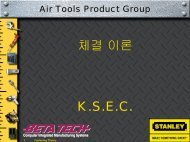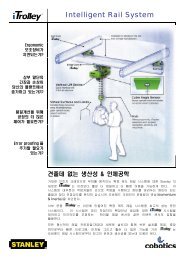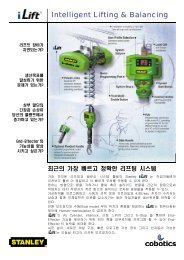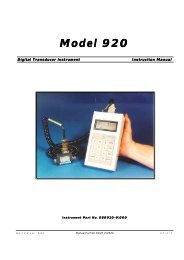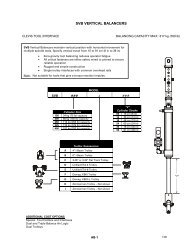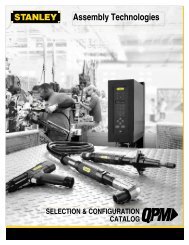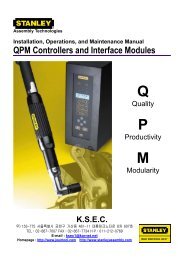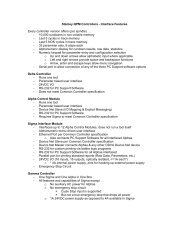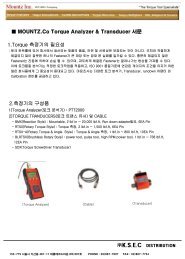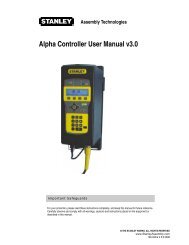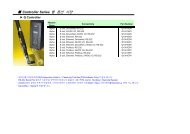Theta Controller User Manual
Theta Controller User Manual
Theta Controller User Manual
Create successful ePaper yourself
Turn your PDF publications into a flip-book with our unique Google optimized e-Paper software.
<strong>User</strong> <strong>Manual</strong><br />
3.2 Operator Protection<br />
WARNING<br />
ROTATING EQUIPMENT<br />
To Avoid Injury:<br />
• Always wear eye and foot protection when operating, installing, or maintaining power tools,<br />
and when in areas where power tools are being used, maintained, or installed. Some<br />
applications may require the use of safety glasses and face shields. Use eye protection that<br />
conforms to ANSI Z87.1.[3] and ANSI Z41-PT99M I/75 C/75.<br />
• Always stay alert when operating tools and/or their accessories. Do no operate tools and/or<br />
their accessories while tired, under the influence of drugs, alcohol or any other mind-altering<br />
substance.<br />
• Repetitive work motions or vibration may be harmful to your hands, arms, shoulders or back.<br />
• Use suitable protective equipment and work methods whenever an application presents a<br />
hazard.<br />
Repetitive Motion<br />
The use of power tools may involve highly repetitive motions of the fingers, hands, wrists, and<br />
shoulders. These repetitive motions can lead to cumulative trauma disorders (CTD). Many<br />
personal and workplace factors can contribute to these disorders.<br />
Currently available data have identified the following risk factors. These risk factors are not<br />
necessarily causation factors of CTDs. The mere presence of a risk factor does not necessarily<br />
mean there is excessive risk of injury. Generally, the greater the exposure to a single risk factor or<br />
combination of factors the greater the risk for CTDs.<br />
• Forceful exertions and motions<br />
• Extreme postures and motions<br />
• Repetitive exertions and motions<br />
• Intended duration of exertion, postures, motions, vibration, and cold<br />
• Insufficient rest or pauses<br />
• Work organization risk factors<br />
• Environmental risk factors<br />
These risk factors span job design and content, operator training, work method, work pace, work<br />
environment, proper tool selection and other work place factors beyond the control of the tool<br />
manufacturer. Tool owners and employers should analyze jobs for all of the risk factors identified<br />
above and take appropriate action.<br />
Some measures which may reduce the risk of CTDs:<br />
• Use minimum hand grip force consistent with proper control and safe operation.<br />
• Keep wrists as straight as possible.<br />
• Avoid repetitive movements of the hands and wrists.<br />
• If wrist pain, hand tingling, numbness, or other disorders of the shoulders, arm, wrist or finger<br />
occur; notify supervisor, discontinue operation, reassign user to a different job; if relief is not<br />
found contact experts skilled in treating such disorders.<br />
Wrist supports, torque reaction devices, and balancers should be used if it can be determined that<br />
such devices can reduce the risk of repetitive motion disorders.<br />
3.2.1 Hearing Protection<br />
Power tool operators and adjacent personnel may be exposed to excessive sound levels. The tool<br />
in use is generally only one of many sources of noise that an operator experiences. Other tools and<br />
machines in the area, joint assembly noise, work processes, and other ambient noise sources all<br />
contribute to the sound level operators are exposed to.<br />
The actual sound level an individual is exposed to and the individual’s exposure time over the<br />
work day are important factors in determining hearing protection requirements. Worker sound<br />
level exposure can only be determined at the job site and is the responsibility of tool owners and<br />
employers.<br />
34



